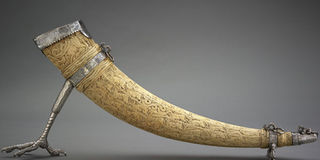New Aga Khan museum uses power of light as fusion tool

An Ivory Horn at the Aga Khan Museum in Toronto, Canada. PHOTO | AGA KHAN MUSEUM | NATION MEDIA GROUP.
What you need to know:
- Inspired by the Aga Khan, who is the 49th hereditary Imam (spiritual leader) of the Shia Ismaili Muslims, the museum is deliberately situated in Canada to urge dialogue and exposition of knowledge among the world’s peoples.
- The building is positioned 45 degrees to solar north to ensure that all exterior surfaces receive natural light.
- The interiors are made of concrete, steel, aluminium panelling, Italian sandstone, patterned glass, stone mosaic floors, polished black granite, Indonesian teak, polished plaster and cast zinc.
As newly established Aga Khan Museum opens its doors to the public in Toronto on Thursday, September 18, its deliberate use of natural light is both literal and metaphorical.
The museum’s design was driven by the concept of light and the architect achieved this by inviting direct and diffuse light into the building in various ingenious ways.
The building is positioned 45 degrees to solar north to ensure that all exterior surfaces receive natural light.
At the same time, the angular walls of white Brazilian granite, a material chosen for its resilience and luminosity, enhance the play of light across the building’s surfaces.
FIGURATIVE POWER
Inspired by the Aga Khan, who is the 49th hereditary Imam (spiritual leader) of the Shia Ismaili Muslims, the museum is deliberately situated in Canada to urge dialogue and exposition of knowledge among the world’s peoples.
Hence its architecture uses the figurative power of natural light as a metaphor for the equalising effect of light on all cultures and religions.
As a global leader, the Aga Khan has been urging different communities of the world to seek knowledge of each other’s cultures and traditions as a way of accommodate one another, and the museum is seen as yet another beacon to this end.
The museum was designed by renowned Japanese architect Fumihiko Maki and built using mostly Brazilian granite and aluminium materials on its exterior.
The interiors are made of concrete, steel, aluminium panelling, Italian sandstone, patterned glass, stone mosaic floors, polished black granite, Indonesian teak, polished plaster and cast zinc.
ASTONISHINGLY BEAUTIFUL
“One of the lessons we have learned in recent years is that the worlds of Islam and the West need to work together much more effectively at building mutual understanding, especially as these cultures interact and intermingle more actively,” said the Aga Khan.
“We hope that this museum will contribute to a better understanding of the peoples of Islam in all of their religious, ethnic, linguistic, and social diversity.”
The Aga Khan Museum’s director, Mr Henry Kim, described it as having an international outlook and home to “astonishingly beautiful” works of art.
“It will showcase the artistic creativity and achievements of Muslim civilisations, from Spain to China.”
The museum was established and developed by the Aga Khan Trust for Culture (AKTC), which is an agency of the Aga Khan Development Network (AKDN).
AKDN is a sister organisation of the Aga Khan Fund for Economic Development (AKFED), which also owns shares in the Nation Media Group.





